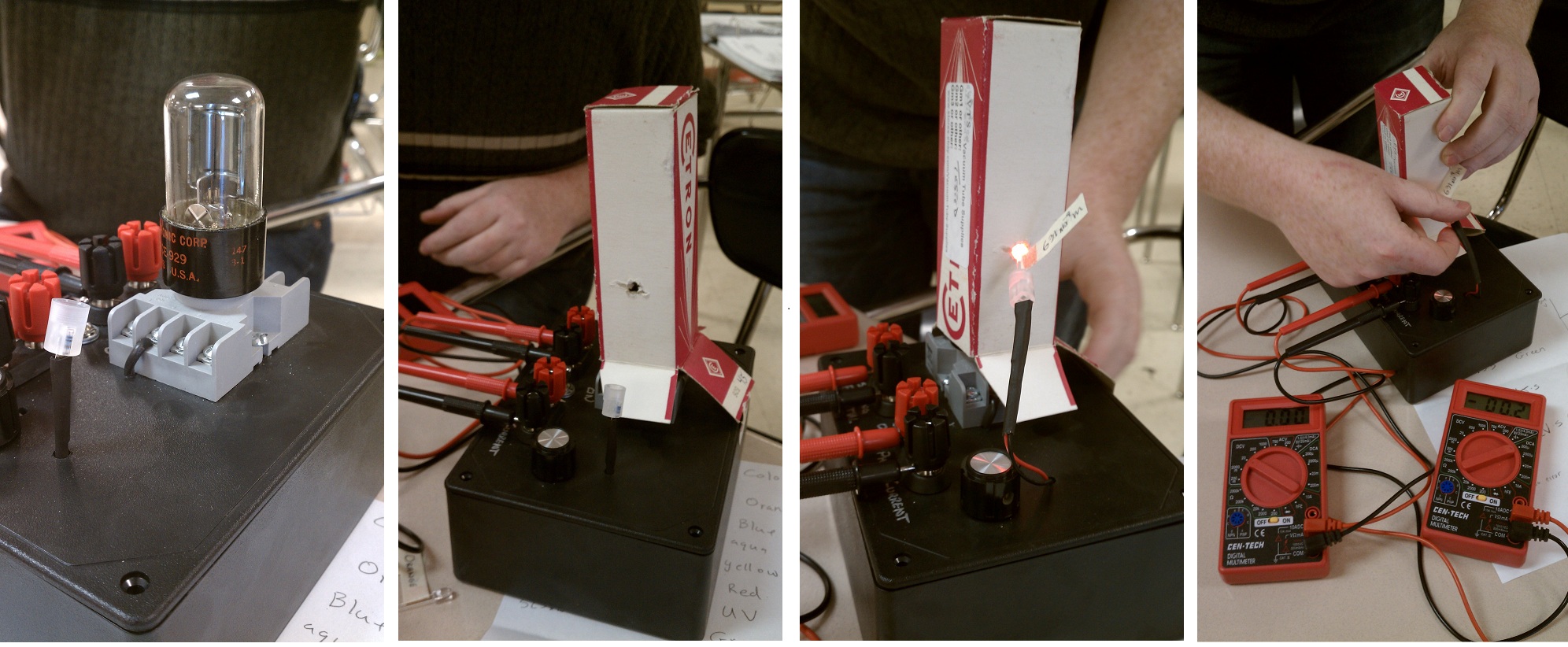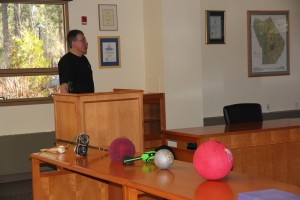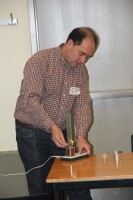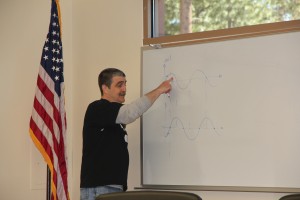Lee Trampleasure, Carondelet High School – deriving the kinematics equation experimentally
Students use TI calculators to derive the kinematics equations. Students graph a linear position-time graph for different constant velocity cars. Student graph the data by hand and then uses linear regression to calculate the slope which will vary from student to student as their best fit lines differ. Students then plot a constant acceleration car and graph that data in their calculators. By taking various tangent lines students create a separate graph of the velocity-time for the car. Using the equation supplied by the calculator they begin to see the relationship between their y-intercept on the y=ax+b equation from the velocity-time graph matches the b in their equation for the position to time graph (x=at^2+bt+c).
David Talcott, Carlmont High School (c/o Bree) – Planck’s constant apparatus
Recently David has posted about a homemade device to derive Planck’s constant. Below an excerpt from David’s explanation:

The concept is pretty simple, shine light on a piece of metal, electrons eject, detect energy of electrons for each frequency of light, plot energy/frequency, slope is planks constant. There is a phet simulation that illustrates this process. The device that I have built use a phototube (1p39 or 929 tube) these can be purchased on eBay for about $35. The rest of the apparatus costs about 35 dollars. The Sargent welch equivalent cost around 800 dollars.
John Boyce , iFly – indoor skydiving

The iFly Education website has more information.
John is encouraging Physics teachers to come to any of the eight iFly facilities as a field trip. Students will be able to tour the facility, learn to fly, participate in flight and walk away with pictures and video. Several members have taken field trips there and enjoyed it.
Frank Cascarano, Foothill College – SawStop.com
A former science teacher became a patent lawyer and developed the SawStop. An electrical signal is put onto the saw blade and as soon as an electrically conductive material comes in contact with the blade the potential difference drops. This signals the saw to stop in a hundredth of a second. A powerful video using a hot dog demonstrates the concept. The blade is electrically isolated and thus the saw must be bought separate and is a “one time shot.”

Mark Hurwitz, Lick-Wilmerding High School
Mark demonstrated his Ring Launcher commonly used to explain Lenz’s Law. The common rings made of plastic, aluminum ring with a slit and an aluminum ring without a slit. In addition to that there is a coil with a light bulb. An additional demonstration then is to move the coil and lightbulb down the length of the rod and observe the brightness increase as it lowers closer to the coil.

This led to a great discussion led by David Kagan about how such demonstrations are not actually demonstrating Lenz’s Law. We look forward to linking David’s full explanation soon.
Bree Barnett Dreyfuss, Amador Valley High School – Leyden Jar examples
Bree explained that her students build a simple Leyden Jar capacitor out of a film can. This year she experimented with the dissectable Leyden Jar available here. Through a lot of dramatic demonstration you can use it to teach students that the charge in a capacitor is stored on the plastic of the cup. Several years ago a student made a much larger version of the Leyden jar (picture coming soon) nicknamed the “Freshmen Killer” that she had not yet used. When the student came back to visit he insisted that they experiment with the Leyden Jar. Bree purposely took the shock provided by the dissectable Leyden Jar (not recommended) and felt a shock through her mid-foreman. When she did the same with the larger Leyden Jar (really not advisable) she felt a shock up to her shoulder. Smaller Leyden Jars can light a small neon bulb but the larger Leyden jar can actually light an 8” fluorescent tube!
Gunjan Raizada Chakravarty – Sowing the Seed of Physics
Dr. G demonstrates several different quick demonstrations of Physics that she uses with younger students to break the cycle of fear surrounding Physics. Several easy to access kid-friendly materials can be used to explain different aspects of students. Dr. G travels to different schools and provides demonstrations to kids about Physics.
Lee Trampleasure, webmaster, updated the membership on the new tools of the website. He introduced informative polls, the new job board and our RSS feed capabilities. Lee is even creating websites for several other sections of AAPT. Way to go Lee!
Be First to Comment